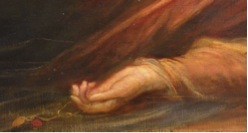“The Drowned Woman” a painting by George Frederic Watts c.1848-1850
 This painting depicts a woman who has washed up on the Thames. The title implies that the woman committed suicide. The woman appears to be very beautiful and is still holding on to a locket possibly a connection to a lover:
This painting depicts a woman who has washed up on the Thames. The title implies that the woman committed suicide. The woman appears to be very beautiful and is still holding on to a locket possibly a connection to a lover:
 The woman in the image is also very simply dressed leading the viewer to believe that she is a servant or comes from little money.
The woman in the image is also very simply dressed leading the viewer to believe that she is a servant or comes from little money.
In the background the viewer can see an industrial image that is covered with smog. It is interesting that the artist is depicting death with the background of technology, possibly he is showing the loom of depression and change that comes from the smog filled industry. And the impact that an industrial change can have on the woman and the threat that looms over all of London.
The painting is full of death and dispair except for one shining hope and that is the glimmer of a single star in the sky.
It is believed that this painting was inspired by “The Bridge of Sighs” by Thomas Hood found here: http://www.poetry-archive.com/h/the_bridge_of_sighs.html
Many connections between the painting and this poem can be found. For example:
One more unfortunate,
Weary of breath,
Rashly importunate,
Gone to her death!
The first stanza outlines the situation of a girl going off to commit suicide, just as it appears the woman in the painting has done.
Look at her garments
Clinging like cerements;
Whilst the wave constantly
Drips from her clothing;
Take her up instantly,
Loving, not loathing.
The third stanza is closely related to the image seen in the picture, her clothing is dripping wet with the filth of the Thames, and the woman being killed by drowning is a very unloving way to die.
The final two stanzas I want to compare to the painting have the biggest impact on it in my opinion:
Make no deep scrutiny
Into her mutiny
Rash and undutiful:
Past all dishonour,
Death has left on her
Only the beautiful.
…
Owning her weakness,
Her evil behaviour,
And leaving, with meekness,
Her sins to her Saviour!
These two stanzas in addition to the position the woman’s body is in-arms spread resembling the cross- on the painting show that the Thames washed away her sins and left her sin free and beautiful.
Both the image and the poem show the struggle of a woman during the 19th century. This woman’s struggle was so great that she ended up committing suicide. Why did she do it, what led her to believe she had no other option? Did she get looked down upon by society for not being a proper woman? Was she struggling with meeting the demands of society?
